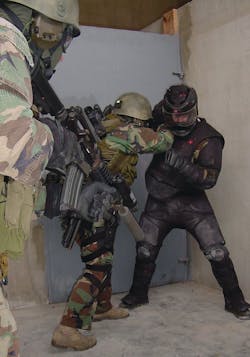On the defensive
Defensive tactics come of age
By Keith W. Strandberg
Defensive tactics training is the most sophisticated it has ever been.
But at the same time, defensive tactics training hasn’t kept up with the times.
How could these two contradictory statements be accurate?
Well, the state of defensive tactics varies greatly from city to city, state to state and region to region. Because there is no centralized depository for defensive tactics, and departments can choose who trains their officers (or who trains their trainers), officers are in varying states of readiness for a hand-to-hand or armed attack.
“I went to teach in North Dakota a little while ago, and I was teaching a technique related to control holds...and to my surprise, no one even knew the control hold...” remembers Richard Nance, defensive tactics expert, Wartac. Nance believes with the explosion of MMA (Mixed Martial Arts), agencies must now look at dealing with attacks and assaults that they hadn’t considered before. "Ground fighting is an important topic...a cop has to have techniques to not get taken down, and have techniques to get back up.”
In the past, departments typically contacted their local martial arts school to learn how to defend themselves during an arrest turned violent. Back then, the emphasis was on controls, moving away from overtly violent striking and kicking.
“The tactics we learned early on were coming from the less aggressive martial arts like Aikido, due to concerns about liability,” acknowledges Fletch Fuller, vice president and director of law enforcement training for ISR Matrix International. “The problem is, everyone realizes that most arrest situations look more like a football scrimmage than an Aikido seminar. There is an inordinate amount of time spent master[ing] complex motor skills without regard to what happens when the fight is on. This type of training...doesn't apply to the truth on the street. It doesn't really prepare the officers because once people resist—they have to improvise.”
Today, specialized defensive tactics programs offered by vendors are designed specifically for law enforcement. They might be based in a particular fighting style (e.g. Aikido, Jiu Jitsu, Karate, Krav Maga, etc.), but they are created for law enforcement.
Reverse engineering:
A relatively new trend in defensive tactics is the study of real altercations between law enforcement and perps. Due to the proliferation of dashboard cameras and other video recording devices, there is finally a host of real-life encounters that can be studied, and from which officers can learn.
“The litmus test is dashboard video and CCTV,” says Tony Blauer, CEO and founder of Blauer Tactical Systems Inc. “If you look at any video of a ‘real fight,’ you never see anyone look cool, you never see anyone look technical, and you never see anyone use the techniques they learn in the academy. If you reverse engineer defensive tactics to support the fights you face, your tactics and procedures will necessarily change. When I ask who controls the fight, the first answer is that the cops do, and that is completely wrong. The level of violence is controlled by the bad guy, the location is chosen by the bad guy and the duration is controlled by the bad guy.
Thanks to video, Blauer points out trainers can reverse engineer defensive tactics to combat various fighting styles. “When a UFC fighter is getting ready for a fight, he studies video [and prepares]. Most cops don’t study the bad guys; they train in martial arts and focus on court-defensible techniques. As a result, most training is not relevant, realistic and rigorous. Technology has kept up with the bad guys but the training is not keeping up.”
Rather than work from imagined scenarios, today's most advanced defensive tactics trainers are looking at real combat and figuring out what the officer has to do to survive and triumph. It certainly makes sense to approach defensive tactics this way—instead of forcing law enforcement to adapt to ritualized martial arts techniques, hoping that the techniques work when they have to, looking at real situations and designing moves and strategies that allow the officers to triumph.
To be successful, any defensive tactics training system has to take into account the realities of law enforcement work, and arm officers with the means to survive. If a department is too worried about liability in these situations, officers are hamstrung and almost sure to fail when facing an opponent who will do anything to win.
“There are really three fights,” says Blauer. “The first fight is between you and you (courage and fear management), the second fight is between you and the bad guy and the third fight is between you and the legal system. Most departments build their defensive tactics around fight three, which puts officers at risk." He believes every move is court defensible if it’s reasonable given the situation. "It might be reasonable to pick up a rock and bash the bad guy over the head if he has your gun and is getting ready to shoot you with it.”
The system of defensive tactics used has to be adapted to real law enforcement use and the lack of training time. The average person in law enforcement is hard-pressed to find time to trian. ISR Matrix’s Fuller adds, “The ISR Matrix was developed as a system that is interesting and challenging and relevant to the mission. You don't want to over-invest in one particular system. Grappling is popular now, but some departments over embrace it. Sometimes they lose context; even though someone knows an arm bar, that doesn't mean it will transfer over in a real life situation.
“In South Florida, we have a large immigrant population in mobile homes,” he continues. “We chase people into a back bedroom and we get tied up with them, and takedowns don't take into account the small size of the area. These don't work when your head is under a commode in a mobile home bathroom—you have to adjust your training to the situations your officers will likely face.”
MMA
The increased popularity of Mixed Martial Arts has had an impact on the nature of resistance. Whether someone is trained in MMA or someone is a fan, grappling and takedowns have become more common, and law enforcement has to be better prepared for this kind of resistance and attack.
“Mixed Martial Arts is impacting things,” agrees Nance. “You might get a guy who likes to go to the gym who picks up a few techniques from watching the fights, and he might get drunk and try some of these on you. Worst case is someone who is training in this stuff and decides to assault an officer. It’s unrealistic to train an officer to be able to deal with someone highly skilled, but it’s important to stay in the fight and hold on until help gets there.”
A possible change in training approach could be to teach defensive tactics like a sport, by adding incremental, progressive resistance as the officers get more accomplished.
“What we have learned from MMA is that everything has to be tested,” says ISR Matrix’s Fuller. “We make a science of the teaching method—when we teach a skill, the student should be able to apply it to a moving subject. We teach it first with a static subject, then we go to progressive resistance. Eventually it becomes a realistic situation where you have to make the technique work. As soon as the people have an idea of where they are going and are doing the technique correctly, we have them apply it in a realistic situation.”
Realistic training
One polarizing topic in defensive tactics is how to introduce realism into training. The risk is officers can become injured in realistic training that involves full contact. One side preaches that officers have to be placed under pressure to gauge how they will respond, to harden them for battle, so to speak, while the other side questions the logic in training that results in officers having to leave their jobs to recover from injuries incurred during training.
Fuller says of ISR Matrix, the scenarios aren't full blown combat but are as realistic as possible. “If you just think the answer is sparring or pressure testing, you are going to injure people in training. This can become really expensive." He says the trick is to balance the need for realistic training with safety by making training scalable to personal limitations and ability. Realistic situations force officers to react instinctively, and the follow up and review is as important as the situations themselves.
“Force option simulations are becoming more popular, because it makes officers think, and the debrief is critical,” says Wartac’s Nance. “If someone is trying to kick your ass, the situation is easier—you know what you have to do…you have to kick his ass." Other situations are not so clear cut, making it a challenge to decide at what point an officer should use force.
Although defensive tactics training has gotten more realistic, it’s still not where it needs to be to be truly effective. Says Blauer: “People still don’t understand some of the essential components of scenario design, to stress-inoculate the students. I have been teaching for twenty years, and I don’t know how it is that I am still talking about this. There will be guys at the conference this week who are still presenting a kung fu class, and people will flock to that class. My scenario training is the most realistic fake stuff in the world,” he says. “The only real fight is the one you haven’t gotten into yet. You want your training to support you in the fight. The answers are out there. You can teach people just about anything by doing more realistic scenarios.”
The future
Defensive tactics will continue to develop, and become more and more suited to application in law enforcement.
“I do think that defensive tactics in general is becoming more progressive," says Nance. "It’s not as stagnant as it was when I first became a cop." Now, forward thinking agencies are combining and integrating firearms training and defensive tactics while in the past the two were kept separate. If there is going to be a sea change in defensive tactics training, however, the demand is going to have to come from the workforce, not administrators.
"As the world gets more and more violent, I believe the officers who put themselves in harm’s way are going to seek out and demand more realistic training,” says Blauer. “They will understand that ‘control tactics’ only work on a specific type of opponent, and conventional defensive tactics doesn't work against real predators.
Law enforcement doesn't need more control tactics, they need ‘out-of-control’ tactics—systems that work when the fight is real.”
Keith W. Strandberg
Keith W. Strandberg is an American freelance writer and award-winning screenwriter/producer of feature films living in Switzerland. He was a former contributing editor for LET more than a decade ago and is happy to be back writing for the magazine.



